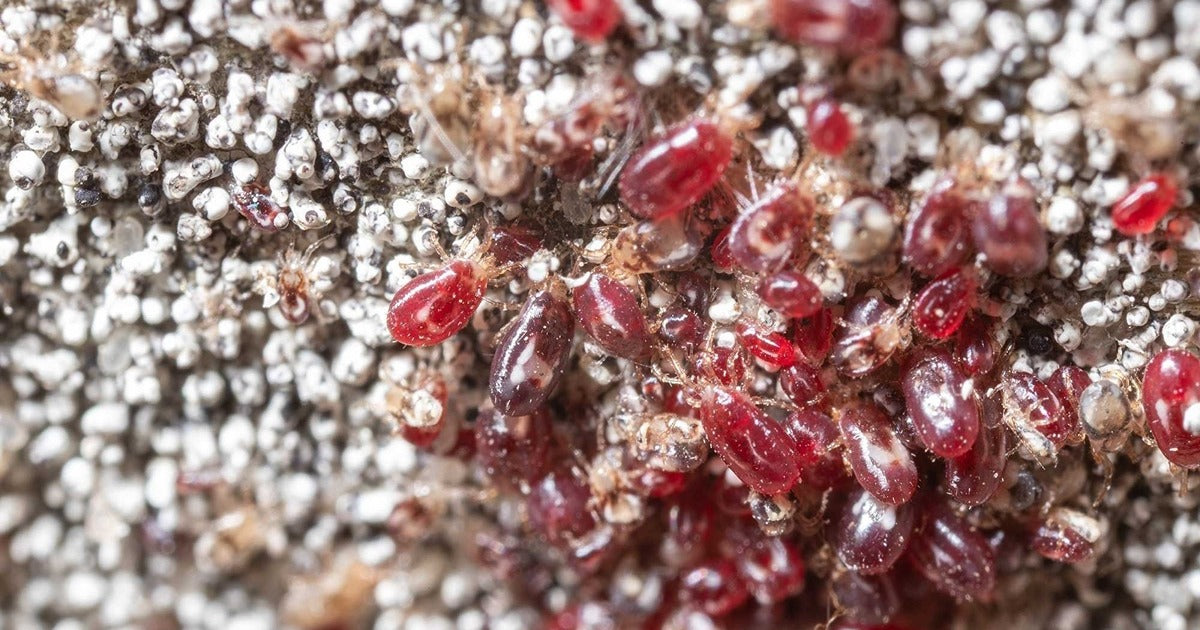
Predatory Mite Available To Combat Red Mite In Poultry
The world of biological control, and the use of natural enemies against pests and parasites, is constantly evolving with new beneficial insects being discovered all the time. A fantastic natural control that was discovered in recent years was, for example, the use of a predatory mite against Red Mite / Northern Fowl Mite found in poultry and other birds.
Biological control is a process in which Dragonfli has build its foundations upon and we are proud to support new solutions against not only plant pests, but also pests of pets and livestock such as Chickens, so we are pleased to be able to continue to supply this predatory mite in the form of our product: Androlis.
Androlis includes these new predatory, Androlaelaps casalis, mites, which were originally found in sparrow nests feeding on Red Mites. They were then tested on poultry to see if they could be used as a natural solution for the control of these pests. The results were impressive and the mites became available to consumers as a safe and natural pest protection for poultry and birds.


The natural predator of Red Mite, the Androlaelaps casalis, is available in our bottles of Androlis.
The Damage Red Mites Can Inflict If Left Untreated
The Red Mite (Dermanyssus gallinae) is a horrible pest as it feeds on the blood of birds. Once it has fed, it will drop to the floor. Reproduction can be very fast, especially in the summer months, and the build up of mites can cause severe distress to birds, causing feather loss and prolonged stress. Other symptoms include reduced egg laying and even cannibalism. The Red Mite has become resistant to many chemical treatments, making it increasingly difficult to treat. The chemical treatments that are available mainly act upon the adults. This leaves eggs to hatch, and ensures a cycle of treatments must be applied that it is then difficult to stop. Often these treatments are unpleasant for the birds and the applicator.

Red Mites suck on the blood of birds. This can cause feather loss, stress, reduced egg laying and even cannibalism to develop in birds.
The image on the right is from the following publication: https://anrcatalog.ucanr.edu/pdf/8162.pdf (Northern fowl mites feeding on poultry. Photo by Brad Mullens, UC Riverside.)
Androlis Ensures No Chemical Treatments Are Required, The Predators Will Eat The Entire Red Mite Life Cycle
The use of Androlis ensures that you will not have to continue with applications of such arduous and unpleasant chemical treatments. Androlis predatory mites will feed on the entire life cycle of the Red Mites, consuming the eggs and adults. The Red Mite is also unable to become resistant to being eaten! The predatory mites will also seek out the Red Mite by crawling into cracks and crevices to pursue their prey. They do not generally go onto the birds but wait for the mites to fall off the birds. Androlis mites are completely safe for use around humans, pets and the birds themselves.

Androlis mites are difficult to identify with the naked eye amidst the carrier material. These predators will not generally go onto the birds but instead seek out Red Mites as they drop off birds.
How To Apply Androlis
Androlis is supplied in various pack sizes from the smallest unit, which treats up to 10 birds to the largest unit, which treats up to 200 birds. The predators can be applied in two ways. You can sprinkle them on the floor of the chicken coop, or aviary. Here they can consume the Red Mites as they drop to the floor.
They can also be applied to the sides of the coops with the use of our Mite Booster Dispenser Tubes which can be attached to sides of the structures. These will hold and release the predators near roosting areas, and the potential hiding areas of the mites. This is especially useful towards the end of the season to prevent the Red Mites overwintering in cracks and crevices.


Androlis can be applied by releasing predators on the floor of coops, or on the sides of coops by pouring predators into our Mite Booster Dispenser Tubes.
If you are applying predators to the floor and cleaning out the litter on a regular basis, remember you may also be taking out the predators, so you will need to reapply, or apply using the mite booster dispensers.
Androlis predators are active down to temperatures of 12.c, temperatures below this will cease their activity. The best times for applying the predators is in the spring and in July. The predators do die back, once Red Mites are consumed, so you may require repeat treatment every 6-8 weeks to retain the optimum balance of predators. Androlis mites do not overwinter, so they will need to be used each year if Red Mite appears.
Androlis offers a natural solution to this horrible pest, not only providing a safe and ecological control method but also an effective one. Give your birds a break from chemical warfare and opt for Androlis predatory mites.
Comments (Responses)
Julian Ives
Hi there, thank you both for getting in touch.
Our Androlis is available to purchase on our website here:
https://www.dragonfli.co.uk/collections/androlis-chicken-mite-control/products/androlis-chicken-mite-predators
Alternatively, simply select ‘Poultry Red Mite’ from our Insect Pests drop-down menu and you will find the product there. All the necessary details regarding the Red Mite and the application instructions for the Androlis can be found by clicking on the product listing.
Kind regards, Julian Ives [Director, Dragonfli]
Hazel williamson
My chickens have red mite how do I bye this product please
Sarah winslade
Could you send me details please for red mite. Price etc and how to order





02 August, 2022
Tracey Hannaford
We have just purchased some androlis from you and have put them in our coop with our red mite infestation. The red mites are all over the outside of the house (we put the androlis inside on the tray, perches and nest boxes). Is this the androlis driving them out and when they’ve eaten the ones inside will they travel to find the ones on the outside? There are too many mites to put our hens in the coop currently, will the androlis still do their business as long as we return the hens when the number of red mites gets lower?
Many thanks
Tracey